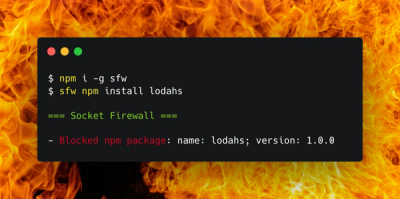
Security News
Package Maintainers Call for Improvements to GitHub’s New npm Security Plan
Maintainers back GitHub’s npm security overhaul but raise concerns about CI/CD workflows, enterprise support, and token management.
Application bootstrapping on top of Fluture Hooks.
Booture uses Hooks (as you might expect) to ensure that whatever happens, once a service is acquired, it will always be disposed. Furthermore, acquisition and disposal of services happens at optimal parallelism.
Booture exposes a single function: bootstrap, which in
combination with Fluture and Fluture Hooks, provides an ideal
platform for control over your application lifecycle.
$ npm install --save fluture booture fluture-hooks
On Node 12 and up, this module can be loaded directly with import or
require. On Node versions below 12, require or the esm-loader can
be used.
You can load the EcmaScript module from various content delivery networks:
There's a UMD file included in the NPM package, also available via jsDelivr: https://cdn.jsdelivr.net/npm/booture@2.1.0/dist/umd.js
This file adds booture to the global scope, or use CommonJS/AMD
when available.
The example below defines four "services": config, postgres, redis,
and app. The App depends on Redis and Postgres having been initialized,
which in turn depend on the Config service.
The consumption of these services happens in the form of binding the App to a port, and waiting for SIGINT to complete the consumption.
import {Future, node, fork, attempt} from 'fluture';
import {bootstrap} from 'booture';
import {hook, acquire, runHook} from 'fluture-hooks';
const acquireConfig = (
attempt (() => ({
redis: {url: process.env.REDIS_URL},
postgres: {url: process.env.POSTGRES_URL},
}))
);
const acquirePostgres = config => (
node (done => require ('imaginary-postgres').connect (config, done))
);
const acquireRedis = config => (
node (done => require ('imaginary-redis').connect (config, done))
);
const closeConnection = connection => (
node (done => connection.end (done))
);
const acquireApp = (redis, postgres) => (
attempt (() => require ('./imaginary-app').create (redis, postgres))
);
const bootstrapConfig = {
name: 'config',
needs: [],
bootstrap: () => acquire (acquireConfig),
};
const bootstrapPostgres = {
name: 'postgres',
needs: ['config'],
bootstrap: ({config}) => hook (acquirePostgres (config.postgres))
(closeConnection),
};
const bootstrapRedis = {
name: 'redis',
needs: ['config'],
bootstrap: ({config}) => hook (acquireRedis (config.redis))
(closeConnection),
};
const bootstrapApp = {
name: 'app',
needs: ['redis, postgres'],
bootstrap: ({redis, postgres}) => acquire (acquireApp (redis, postgres)),
};
const servicesHook = bootstrap ([ bootstrapConfig,
bootstrapPostgres,
bootstrapRedis,
bootstrapApp ]);
const withServices = runHook (servicesHook);
const program = withServices (({app}) => Future ((rej, res) => {
const conn = app.listen (3000);
conn.once ('error', rej);
process.once ('SIGINT', res);
}));
fork (console.error) (console.log) (program);
Some things to note about the example above, and general usage of Booture:
servicesHook is a Hook, so before running it, it can be composed
with other hooks using map, ap, and chain, and even used in the
definition of other bootstrappers.program is a Future, so nothing happens until it's forked. Before
forking it, it can be composed with other Futures using map, ap,
bimap, and chain, or any of the other functions provided by Fluture.type Name = String
type Services a = Dict Name a
data Bootstrapper a b = Bootstrapper {
name :: Name,
needs :: Array Name,
bootstrap :: Services b -> Hook (Future c a) b
}
bootstrap :: Array (Bootstrapper a b) -> Hook (Future c a) (Services b)Given a list of service bootstrappers, returns a Hook that represents the
acquisition and disposal of these services. Running the hook allows for
consumption of the services.
FAQs
Application bootstrapping on top of Fluture Hooks
The npm package booture receives a total of 2 weekly downloads. As such, booture popularity was classified as not popular.
We found that booture demonstrated a not healthy version release cadence and project activity because the last version was released a year ago. It has 3 open source maintainers collaborating on the project.
Did you know?

Socket for GitHub automatically highlights issues in each pull request and monitors the health of all your open source dependencies. Discover the contents of your packages and block harmful activity before you install or update your dependencies.

Security News
Maintainers back GitHub’s npm security overhaul but raise concerns about CI/CD workflows, enterprise support, and token management.

Product
Socket Firewall is a free tool that blocks malicious packages at install time, giving developers proactive protection against rising supply chain attacks.

Research
Socket uncovers malicious Rust crates impersonating fast_log to steal Solana and Ethereum wallet keys from source code.